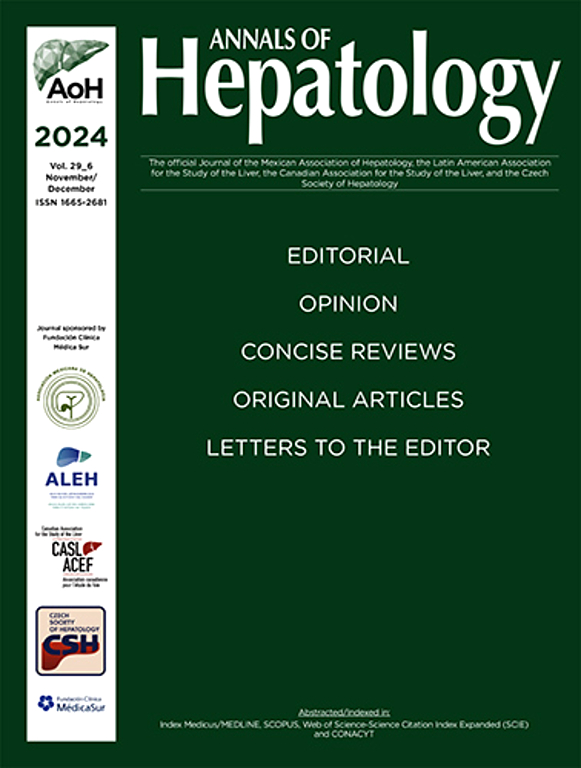Experience with dexmetomidine in the management of alcohol withdrawal syndrome for patients with cirrhosis
IF 3.7
3区 医学
Q2 GASTROENTEROLOGY & HEPATOLOGY
引用次数: 0
Abstract
Introduction and Objectives
Lorazepam is the first-line treatment in patients with alcohol withdrawal syndrome (AWS). In patients with cirrhosis and AWS, the use of dexmetomidine (DXM) has been poorly studied. The objective of this study is to report the effect of DXM in patients with cirrhosis and AWS.
Materials and Patients
Observational, retrospective, descriptive and analytical study. Patients with cirrhosis and AWS, treated with lorazepam, DXM, or both, were included. The Clinical Institute Withdrawal Assessment of Alcohol Scale (CIWA-Ar) data was collected before and after treatment, as well as the days of in-hospital stay (IHS). The quantitative variables were summarized using non-parametric descriptive statistics according to the distribution of the variables (average and range), as well as frequencies and percentages in the case of qualitative variables. To compare between three independent groups, the Kruskal-Wallis (KW) and Jonckheere-Terpstra (JT) tests were used. A significant difference was considered one with a value of p<0.05.
Results
39 patients were included, 37 (94.9%) men, average age 41 (27-66) years, alcohol consumption 287 (64-960) g/day, CIWA-Ar at admission 20 (10-46) points, Child -Pugh 10 (5-14) points, MELD-Na 16 (8-40) points. Regarding the AWS treatment: 17 (43.6%) received lorazepam, 13 (33.3%) DXM, and 9 (23.1%) lorazepam + DXM. When compared between groups there were no differences in terms of days of IHS [4 (1-30) vs. 3 (1-18) vs. 2 (1-5) respectively for lorazepam, DXM, lorazepam + DXM; KW p=0.86, JT p=0.82], nor in terms of CIWA-Ar at 24 hours post-treatment [7 (1-19) vs. 6 (0-15) vs. 5 (2-23) respectively for lorazepam, DXM, lorazepam + DXM; KW p=0.19, JT p=0.45]. No serious adverse effects were reported with any of the three strategies.
Conclusions
DXM appears to be an effective and safe option for the treatment of AWS in patients with cirrhosis. However, clinical trials are required to validate our findings.
右美托咪定治疗肝硬化患者酒精戒断综合征的经验
简介与目的劳拉西泮是酒精戒断综合征(AWS)患者的一线治疗药物。在肝硬化和AWS患者中,右美托咪定(DXM)的使用研究很少。本研究的目的是报告DXM在肝硬化和AWS患者中的作用。材料和患者:观察性、回顾性、描述性和分析性研究。包括肝硬化和AWS患者,用劳拉西泮、DXM或两者同时治疗。临床研究所酒精戒断评估量表(CIWA-Ar)数据收集治疗前后以及住院天数(IHS)。根据变量的分布(平均值和极差)以及定性变量的频率和百分比,采用非参数描述性统计对定量变量进行总结。为了比较三个独立组之间的差异,采用Kruskal-Wallis (KW)和Jonckheere-Terpstra (JT)检验。显著性差异为0.05。结果纳入39例患者,男性37例(94.9%),平均年龄41(27 ~ 66)岁,饮酒287 (64 ~ 960)g/d,入院时CIWA-Ar 20(10 ~ 46)分,Child -Pugh 10(5 ~ 14)分,MELD-Na 16(8 ~ 40)分。关于AWS治疗:17例(43.6%)接受劳拉西泮治疗,13例(33.3%)接受DXM治疗,9例(23.1%)接受劳拉西泮 + DXM治疗。两组间比较,劳拉西泮、DXM、劳拉西泮 + DXM的IHS天数分别为4(1-30)、3(1-18)、2 (1-5);KW p=0.86, JT p=0.82],治疗后24小时CIWA-Ar也没有变化[劳拉西泮,DXM,劳拉西泮 + DXM分别为7(1-19)比6(0-15)比5 (2-23);KW p=0.19, JT p=0.45]。三种策略均未发现严重的不良反应。结论sdxm是一种有效且安全的治疗肝硬化患者AWS的方法。然而,需要临床试验来验证我们的发现。
本文章由计算机程序翻译,如有差异,请以英文原文为准。
求助全文
约1分钟内获得全文
求助全文
来源期刊

Annals of hepatology
医学-胃肠肝病学
CiteScore
7.90
自引率
2.60%
发文量
183
审稿时长
4-8 weeks
期刊介绍:
Annals of Hepatology publishes original research on the biology and diseases of the liver in both humans and experimental models. Contributions may be submitted as regular articles. The journal also publishes concise reviews of both basic and clinical topics.
 求助内容:
求助内容: 应助结果提醒方式:
应助结果提醒方式:


